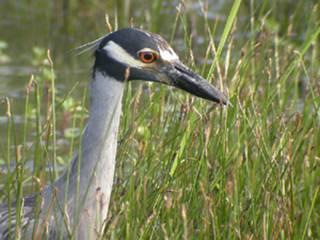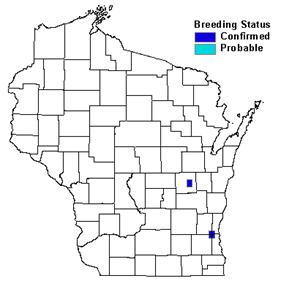Photo by Travis Mahan


Status/Protection
- Global Rank: G5 Key to global and state ranks
- State Rank: S1B
- WBCI Priority: SGCN
Population Information
The Federal BBS information can be obtained at http://www.mbr-pwrc.usgs.gov/bbs/bbs.html by clicking on Trend Estimates and selecting the species in question. All estimates are for time period (1966-2005).
- Federal Breeding Bird Survey: non-significant decline
- Federal Breeding Bird Survey (WI): N/A
- Federal Breeding Bird Survey (BCR 23): N/A
- Federal Breeding Bird Survey (BCR 12): N/A
- WSO Checklist Project: stable (1983-2007)
Life History
- Breeding Range: Atlantic and Gulf Coast states extending inland along the Mississippi River and its tributaries (Watts 1995).
- Breeding Habitat: Bottomland Hardwood, Emergent Marsh, coastal wetlands, both freshwater and saltwater (Watts 1995).
- Nest: Platform of sticks within a clump of trees and shrubs (Ehrlich et al. 1988).
- Nesting Dates: Eggs: Mid-May to late June (Robbins 1991).
- Foraging: Stalk and strike, ground glean (Ehrlich et al. 1988).
- Migrant Status: Short-distance migrant, Neotropical migrant.
- Habitat use during Migration: Similar to breeding habitat (Watts 1995).
- Arrival Dates: Mid-April to late May (Robbins 1991).
- Departure Dates: Early August to mid-October (Robbins 1991).
- Winter Range: Gulf Coast states, Caribbean islands, coastal South America (DeGraaf and Rappole 1995).
- Winter Habitat: Similar to breeding habitat but often more coastal locations, mangroves, riparian swamps (Watts 1995).
Habitat Selection
Breeding habitat used by Yellow-crowned Night-Heron varies geographically but is generally always near water (Watts 1995). In coastal areas, it nests on bay, barrier, and dredge spoil islands (Watts 1995) whereas in Wisconsin and other inland locations, it is associated with floodplain forests and isolated woods near rivers, sloughs, and overflows (Mumford and Keller 1984, Mossman 1988, Robbins 1991). In southeastern Missouri, nest sites were characterized as saw-timber stands with moderate to sparse understories and 97% of nests were located in oak trees (Laubhan and Reid 1991). Elsewhere in its range, a wider variety of tree species are used for nesting, including red birch, silver maple, sycamore, ash, and sweet gum (Mumford and Keller 1984). The Yellow-crowned Night-Heron nests alone or in loose aggregations but typically does not share nest trees with other nesting pairs (Watts 1995).
Habitat Availability
Wisconsin is on the extreme northern edge of the Yellow-crowned Night-Heron range (Watts 1995). In recent decades, individuals have been found in floodplain forests along the Sugar River in Rock and Green counties (W. Mueller, pers. obs.), in Kenosha, Racine, and Milwaukee counties, in the Mississippi and Wisconsin River floodplain forests, and along the Wolf River (BER 1997, Mossman 1988, Robbins 1991). Although bottomland hardwood and other floodplain forests have fared better than many of Wisconsin’s native habitats, loss and fragmentation have reduced the amount of suitable stands available. It is estimated that only 8% of presettlement floodplain forest remains in moderate to high quality condition (Mossman 1988). Invasive plant species, particularly reed canary grass, may impede regeneration in floodplain forests. Development pressures also continue to threaten remaining floodplain forest tracts (WDNR 2005).
Population Concerns
Although the Yellow-crowned Night-Heron is at the northern edge of its range in Wisconsin, some individuals are found in the state every year (Robbins 1991, Anderson 2006). Breeding Bird Survey data suggest a non-significant annual decline range-wide for this species (Sauer et al. 2005). Population trends in Wisconsin are unknown because of the Yellow-crowned Night-Heron’s rarity in the state. This species is rarely recorded on either the Wisconsin Breeding Bird Surveys or the Wisconsin Checklist Project (Rolley 2005, Sauer et al. 2005) and only two breeding attempts were confirmed during the six seasons of the Wisconsin Breeding Bird Atlas (1995-2000; Anderson 2006).
Targeted survey efforts will be necessary to better assess this species’ current status in Wisconsin. Because Wisconsin is far from the Yellow-crowned Night-Heron’s core distribution and population, it is unlikely to ever be common here. However, the continued loss and fragmentation of bottomland hardwood forests south of the tension zone are serious threats to the small state population.
Recommended Management
Management efforts for this species should focus on reducing forest fragmentation along the major river systems of southern Wisconsin. In known nesting areas, managers should minimize disturbance during the nesting period (BER 1997). Conservation and management strategies for this species should be focused in the Western Coulee and Ridges ecological landscape (WDNR 2005) with key conservation sites including Tiffany Wildlife Area/Nelson-Trevino Bottoms and Whitman Bottoms State Natural Area in Buffalo County, Avon Bottoms in Rock County, Wauzeka Bottoms in Crawford County, and Yellow River Oxbows State Natural Area in Juneau County.
Research Needs
More information is needed on the distribution and population trend of this species in Wisconsin. The Yellow-crowned Night-Heron preys extensively on crayfish in Wisconsin (BER 1997), which have thermal tolerances within relatively narrow ranges (Watts 1995). Studies are needed to investigate the influence of thermal regime on breeding biology and geographic distribution (Watts 1995). Detailed studies also are needed to compare the breeding biology of saltwater and freshwater populations.
Information Sources
- Chequamegon National Forest Bird Survey (NRRI) species account: http://www.nrri.umn.edu/mnbirds/accounts/YCNHa2.htm
- Cornell Lab of Ornithology species account: http://birds.cornell.edu/programs/AllAboutBirds/BirdGuide/Yellow-crowned_Night-Heron_dtl.html
- Illinois Natural History Survey page: http://www.inhs.uiuc.edu/chf/pub/ifwis/birds/yellow-crowned-night-heron.html
- North American Breeding Bird Survey: http://www.npwrc.usgs.gov
- Waterbird Conservation for the Americas: http://www.waterbirdconservation.org/pubs/ContinentalPlan.cfm
- Wisconsin Breeding Bird Atlas: http://www.uwgb.edu/birds/wbba/
- Wisconsin Department of Natural Resources factsheet: http://www.dnr.state.wi.us/org/land/er/factsheets/birds/Ynther.htm
References
- Anderson, J.S. 2006. Yellow-crowned Night-Heron. In Atlas of the Breeding Birds of Wisconsin. (N.J. Cutright, B.R. Harriman, and R.W. Howe, eds.). The Wisconsin Society for Ornithology, Inc. 602pp.
- Bureau of Endangered Resources (BER). 1997. The endangered and threatened vertebrate species of Wisconsin: status, distribution, and life history. Wisconsin Department of Natural Resources. Publ. No. ER-091. Madison, WI.
- DeGraaf, R.M., and J.H. Rappole. 1995. Neotropical migratory birds: natural history, distribution, and population change. Comstock Publ. Assoc., Cornell Univ. Press, Ithaca, NY.
- Ehrlich, P.R., D.S. Dobkin, and D. Wheye. 1988. The birders handbook: a field guide to the natural history of North American birds. Simon & Schuster, Inc. New York.
- Laubhan, M.L. and F.A. Reid. 1991. Characteristics of Yellow-crowned Night-Heron nests in lowland hardwood forests of Missouri. Wilson Bulletin 103 (3): 486-491.
- Mossman, M.J. 1988. Birds of southern Wisconsin floodplain forests. Passenger Pigeon 50(4): 321-337.
- Mumford, R.E. and C.E. Keller. 1984. The birds of Indiana. Indiana University Press. 376pp.
- Robbins, S. D. 1991. Wisconsin birdlife: population & distribution, past & present. Univ. of Wisconsin Press, Madison, WI.
- Rolley, R. 2005. Wisconsin Checklist Project. http://dnr.wi.gov/org/land/wildlife/harvest/reports/07checklist.pdf (13 April 2007)
- Sauer, J.R., J.E. Hines, and J. Fallon. 2005. The North American Breeding Bird Survey, Results and Analysis 1966 - 2005. Version 6.2.2006. USGS Patuxent Wildlife ResearchCenter, Laurel, MD.
- Watts, B.D. 1995. Yellow-crowned Night-Heron (Nyctanassa violacea). In The Birds of North America, No. 161 (A. Poole and F. Gill, eds.). The Academy of Natural Sciences, Philadelphia, and The American Ornithologists’ Union, Washington, D.C.
- Wisconsin Department of Natural Resources (WDNR). 1995. Wisconsin’s Biodiversity as a Management Issue. Online at http://dnr.wi.gov/org/es/science/publications/rs915_95.htm
Contact Information
- Compiler: William P. Mueller, iltlawas@earthlink.net
- Editor: Kim Kreitinger, K.Kreitinger@gmail.com
